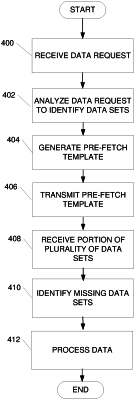| CPC H04L 67/568 (2022.05) | 9 Claims |

|
1. A computing platform, comprising:
at least one processor;
a communication interface communicatively coupled to the at least one processor; and
a memory storing computer-readable instructions that, when executed by the at least one processor, cause the computing platform to:
receive a data request;
analyze, using a machine learning model executed by a pre-fetch engine, the data request to identify a plurality of data sets responsive to the data request;
generate, based on the analyzing, a pre-fetch template including the identified plurality of data sets;
transmit, to a plurality of data repositories and via a mesh data transmission network, the pre-fetch template;
receive, from a first data repository of the plurality of data repositories, a portion of the plurality of data sets, wherein the portion of the plurality of data sets includes fewer than all data sets included in the pre-fetch template and is retrieved from the first data repository by a first data controller associated with the first data repository, and wherein the portion of the plurality of data sets complies with data transmission requirements of a location of the first data repository, wherein the data transmission requirements of the location of the first data repository include restrictions on timing of transmission of data sets stored by the first data repository and restrictions on types of data that may be transmitted from the location of the first data repository to a different location;
analyze the received portion of the plurality of data sets to identify missing data sets of the plurality of data sets;
process the received portion of the plurality of data sets, wherein processing the received portion of the plurality of data sets includes at least one of: ignoring the identified missing data sets during the processing or inserting a substitute value in the identified missing data sets during the processing; and
update the machine learning model based on the received portion of the plurality of data sets.
|